Four Player Non-Partnership Briscola: Briscola is sometimes played as a four player, non partnership game. In this case, the game is played identically to the standard version, however each player retains his own, independent score
and plays independently of all the other players. Each hand is usually considered a complete game, however, if two or more players tie for the highest score at the end of a hand, that hand is ignored and another hand must be played amongst all four players.
Two Player Briscola: Briscola is also commonly played as a two player game. The game is virtually identical to the standard four player variation with the obvious difference that there are no partnerships. Thus, each player retains his own score and there is no
signaling to another player the value of the hand. Each hand is usually played as a complete game, with the player capturing the most points in cards during the hand declared the winner. If each player captures exactly 60 points, the hand is a tie and a replacement hand should be played as a tie-breaker.
Three Player Briscola: Similar to the two player variant, the three player game is also played cut-throat (no partnerships). In order to allow the cards to deal and play out evenly amongst the three players, before play begins any one card of rank two is removed from the deck and play. Each hand is usually played as a complete game. However, if two or more players are tied for the highest score at the end of a hand, a replacement hand should be played out amongst all three players to determine the winner.
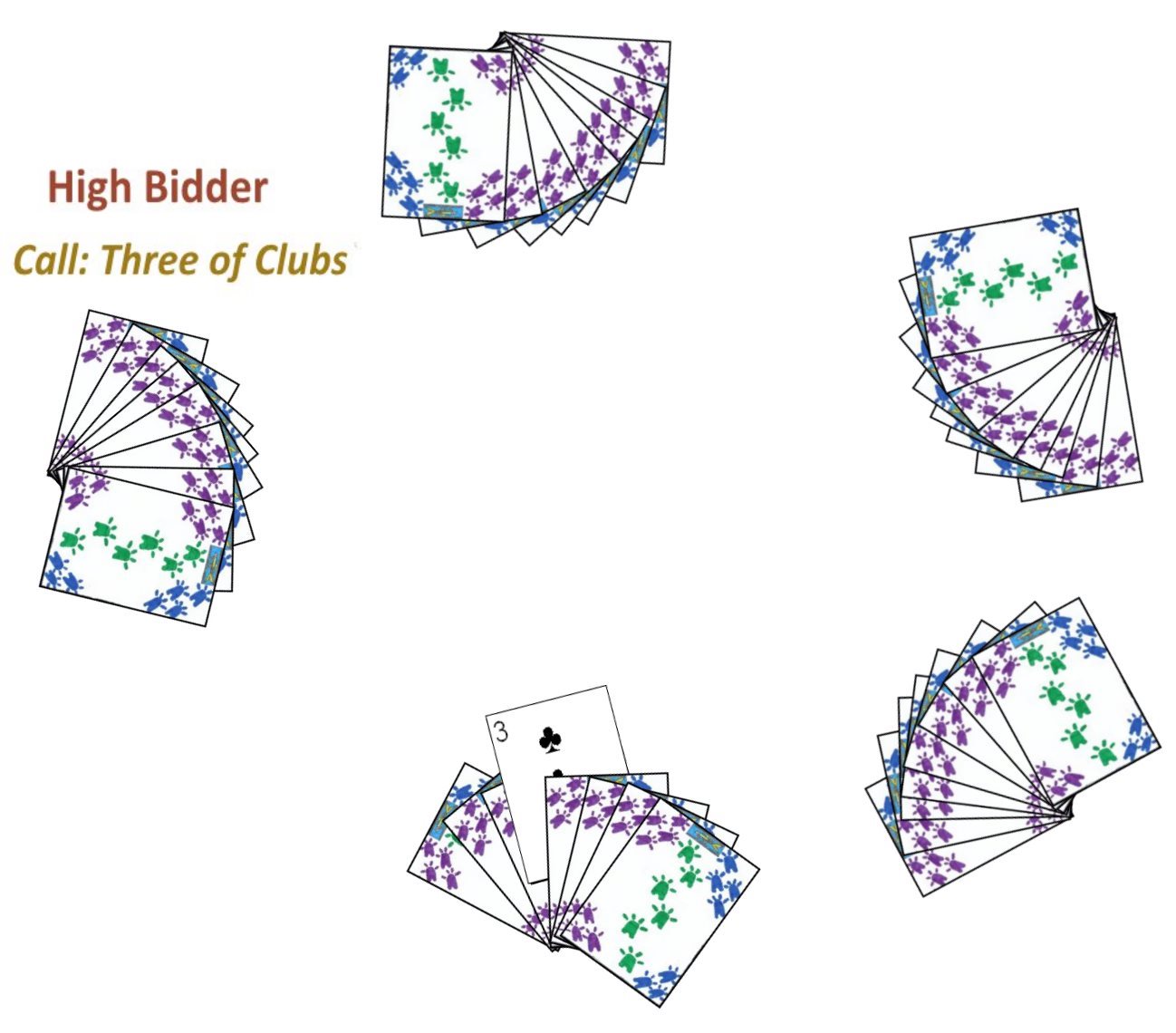 Briscola Chiamata
Briscola Chiamata: Briscola Chiamata, also known as Call Briscola, is an exciting variant of Briscola designed to be played by five players. Partnerships are featured in this variant, however, these are temporary for one hand. The game uses the same deck as used for the four player version of the game and the ranking of the cards in the deck is the same as in that version.
In this variant, the dealer deals out the entire deck outright, such
that each player receives exactly eight face-down cards. There are no
cards remaining after the deal and no card is exposed to determine the
Briscola suit for the hand (as would normally be done in the standard variant of the game). After the hands are dealt, a bidding round begins, starting with the player to the dealer's immediate right and continuing in a counter-clockwise direction around the table.
A bid is a number of points that player believes he can score during the hand, if allowed to name the Briscola suit
to be used for the hand. The bid continues around the table, with each player in turn, either making a higher bid than any previous bid or passing. The bidding continues around the table until all players pass. Once a player passes during the auction however, he must continue to pass during the auction and may not re-enter the bidding in this hand. Once the high bid has been determined, the player making that bid becomes the Bidder for the hand.
This high bidder then calls out a specific card (by rank and suit). This call has two purposes. Firstly, the suit of the called card is set as the Briscola (or trump) suit for the hand. Secondly, whichever other player has the card called becomes the hidden partner for the high bidder. However, this player should not announce this or make any other indication that he is the high bidders partner for the hand. Once the called card is played to a trick, it will become obvious who this player
is. The remaining three players are also in a temporary partnership to defeat the high bidder and his hidden partner. Note that the high bidder also has the option to call a card he already has in his own hand. In this case, he will play alone with no temporary partner, and has the opportunity to earn a higher score for the hand.
After the high bidder has called his card to determine the Briscola Suit (and a potential partner for the hand), play of the hand begins, with the high bidder leading the first card to the first trick. The rules of play to tricks is identical to the other variants of Briscola as described above.
After all eight tricks have been played and won, the tricks won by the high bidder and his hidden partner (if any) are combined and examined to determine if that temporary team managed to win at least as many points as the high bid. If so, the high bidder earns 2 points for the hand and his hidden partner earns 1, while three opponents each lose 1 point. If the high bidder and his temporary partner fails to capture at least as many points as bid, the high bidder loses 2 points and his hidden partner loses 1, while the three opponents each earn one point. If the high bidder played without a hidden partner (calling a card already in his own hand), and manages to earn at least as many points as bid, he earns 4 points and each opponent loses 1 point. However, if he played alone and was unable to capture at least as many points during the hand as bid, he loses four points instead and each opponent earns one point.
The first player to accumulate 11 points is declared the overall winner of the game. If two or more players reach this total in the same hand, additional hands are played until one player completes a hand with more points than any other player.
Briscola Chiamata - Low Card Bidding: Briscola Chiamata is sometimes played with a different system of bidding. In this variant, each player, on his bid, names a specific ranked card (such as Ace or Three). He does not,
however, as of yet, name a suit. After each player has had one opportunity to bid (or pass), the player who bid the lowest ranked card in the deck becomes the high bidder
for the hand. This player then states a specific suit, and the other player who has, in hand, the card
as called by the high bidding players card rank called, and in the suit he stated, becomes that player's partner, unbeknownst to all the other players (including the caller) until that card is played to a trick. As in standard Briscola Chiamata, the card called may
actually be in the high bidder's hand, in which case he plays without the aid of a partner. In all other aspects, this variant is played identically to standard Briscola Chiamata.
Briscola Scoperta: Briscola Scoperta is
another variant of Briscola in which the rule differences can
drastically change the gameplay. This variant can be used with the two,
three and four player variants of the game. The game is played
identically to those versions with one major difference. After the deal each player lays his hand face-up on the table in front of himself and the game is played with each player playing from an open hand. Other than these exposed hands, the game is played identically to the standard versions of Briscola.
Bixkla: Bixkla is a close variant of the Italian game Briscola but which is commonly played in the nation of Malta. The game uses the same 40 card deck as is used in Briscola, however the ranking of the cards as found in that deck are slightly different than as in Briscola. The ranking thus used in Bixkla is as follows (from highest to lowest): Ace, 3, King, Jack, Queen, 7, 6, 5, 4, 2. Bixkla is designed for play by four players playing in two partnerships of two players each.
Determination of partnerships, seating positions and first dealer can be performed using the same procedures as in standard Briscola. Each player should at the table directly across the table from his partner.
The dealing procedure is also identical to the standard game, with each player receiving three total cards and the next card from the remaining stock turned face-up on the table. The suit of this card sets the trump suit to be used for this hand. After this, play of the hand begins with the player at the dealer's immediate left playing the first card to the first trick and each player in a clockwise direction playing one card to that same trick.
The leader to a trick may play any card of choice from his hand to the trick. Each other player then adds a card from his hand to the trick, also playing any card of choice from his hand. After each player has played one card to the trick, in turn, the trick is examined to determine it's winner.
If the trick contains one or more cards in the trump suit, the highest such card in that trump suit wins the trick. If the trick does not contain any cards in the trump suit, the highest ranked card played of the suit originally led to the trick wins that trick. The cards won in tricks are thus set aside out of play, for later scoring at the end of the hand. After each trick is won, each player draws one card from the top of the remaining stock into his hand. The winner of the trick draws the first card, and each other player, in a clockwise direction then draws one such card. Once the stock has been exhausted, play continues, obviously without this draw until the players exhaust the cards found in the hand.
After all tricks have been played and won, each partnership then reviews all the cards the members of that partnership managed to win during the hand. Each card in the deck has a specific point value, as per the following chart:
| Card | Point Value |
|---|
| Ace | 11 |
| 3 | 10 |
| King | 4 |
| Jack | 3 |
| Queen | 2 |
| 7, 6, 5, 4, 2 | 0 |
|
|
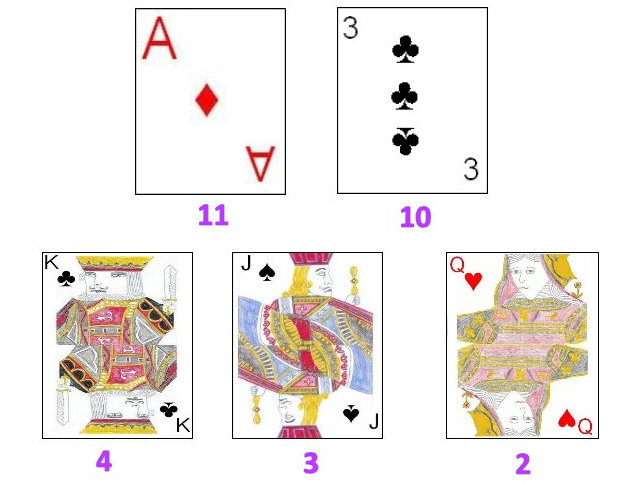 |
Whichever partnership manages to earn the most card points during that hand is said to win the game (and one accumulated Game Point). If both teams tie for the number of points captured during the hand, that game is a tie, with neither team declared the victor. After a set number of hands, the team with the highest number of Game Points (equal to the number of Games won) is declared the winner.
As in Briscola and some of it's other variants, it is commonplace for players to use special
signaling to indicate to their partner the cards they currently have in the hand. These signals are often the same as or very similar to those used in Briscola.
Belka: Belka is a game that shares a number of similarities to Briscola. Belka originated in the city of Karaganda in the country of Kazakhstan and is one of the most popular games in that
geographical area, particularly in the Northern half of the country.
Belka is designed for four players playing in two partnerships and uses a reduced 32 card deck. This deck can be formed from a standard 52 card deck by removing all cards below rank seven from that standard deck. The four Jacks are permanent trump suits, so the ranking of the cards in the designated trump suit for a hand is as follows
(from highest to lowest): Jack of clubs, Jack of spades, Jack of hearts, Jack of diamonds, Ace of trump suit, 10 of trump suit, King of trump suit, Queen of trump suit, 9 of trump suit, 8 of trump suit, 7 of trump suit. It should be remembered that, as the four Jacks are always considered the four highest cards in the trump suit, they are full members of the designated trump suit and can and would be played at any time a card from the trump suit would appropriately be played. In the non-trump suits, the ranking of the cards is as follows (also shown from highest to lowest): Ace, 10, King, Queen, 9, 8, 7.
Determination of seating partnerships and first dealer can be performed using a variety of methods, with draw for high cards a common method. Using that method, the players drawing the two highest ranked cards from a face-down shuffled deck would play as partners, opposed by a second partnership formed from the two players drawing the two lowest cards. Each player should sit at the table directly across from his partner for that game. The player drawing the highest card of all is set as the first dealer. After each hand the role of dealer rotates around the table in a clockwise direction.
The dealer for the hand should then thoroughly shuffle the deck and offer it to the player at his right to cut. After the cut, the player then should begin dealing the cards in a clockwise direction around the table, starting with the player at his immediate left. He deals the cards one-at-a-time and face-down, continuing until the entire deck has been dealt, with each player having received a total of eight cards.
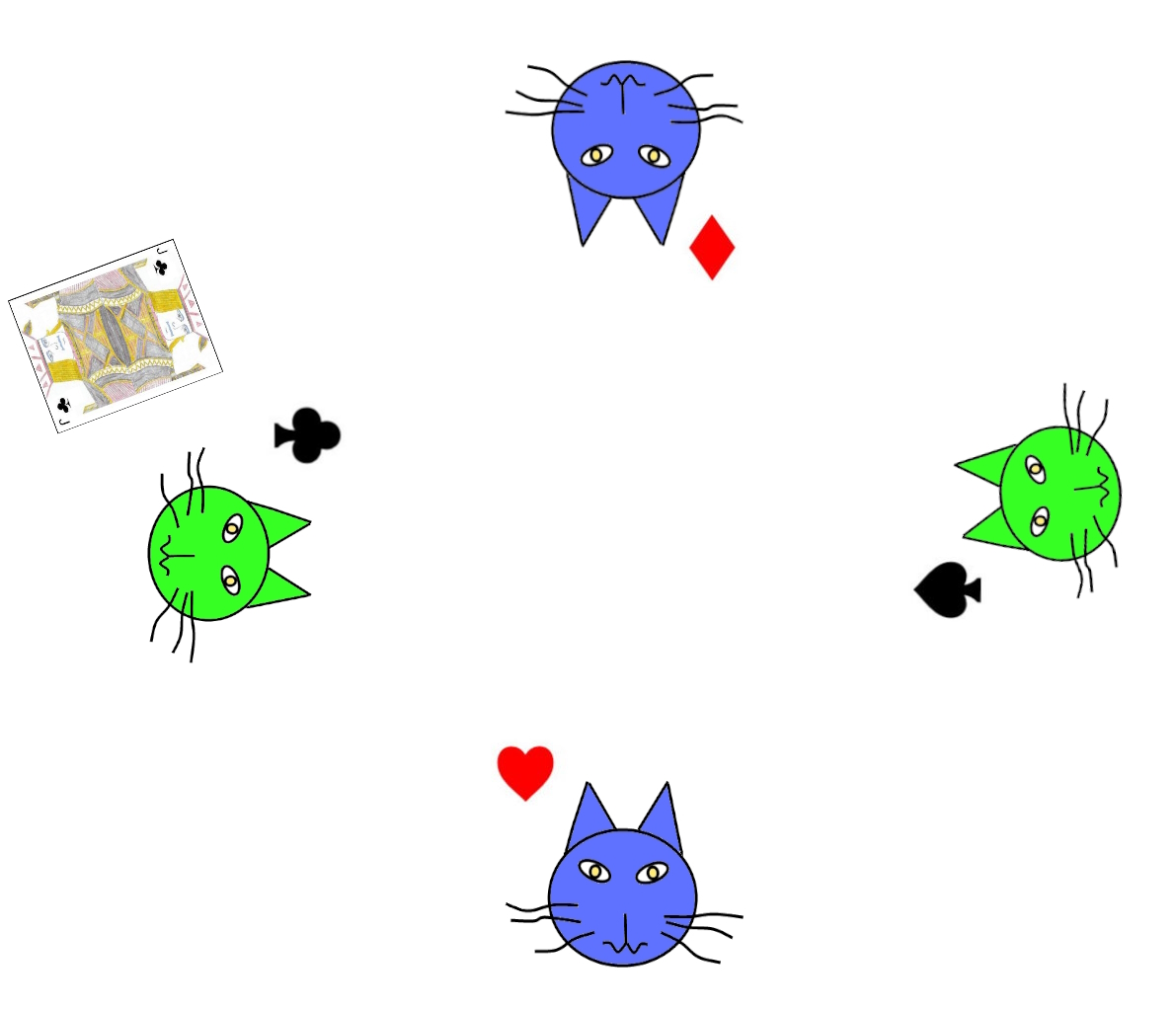
The determination of the selected trump suit is quite unique in Belka. On the first hand of every game, the trump suit is always set as clubs. The player who is dealt the Jack of clubs on this first hand should take note of this, but need not announce it until the end of that hand. Once the first hand has been played, the recipient of that
same card in each subsequent deal helps determine the trump suit to be used in later hands. Each player is then represented by a specific suit. The player who had thus received the Jack of clubs is set, as a designator, the suit of clubs, the player to his immediate left is set as the suit of diamonds, the player at his immediate right the suit of hearts, and his partner (the player directly across from him) the suit of spades. Thus, on each hand after the first whichever player is dealt the Jack of clubs must announce this, and whatever his suit designation was, sets the trump suit to be used for that hand.
After it is determined what the trump suit should be for that hand, play can begin. The player to the right of the dealer plays the first card to the first trick, and each other player, in a clockwise direction then also plays one card from their hand to the
same trick.
The leader to a trick can play any card of choice from their hand. Each other player, in turn, must then play a card of the suit originally led to the trick if they have one. If the player has no such card in the led suit, they may play any card from their hand to the trick, including a card from the trump suit (recalling that the four Jacks are considered automatic members of the current trump suit).
After each player has played one card to the trick, it is determined who has won that trick. The player of the highest card in the trump suit played to that trick is considered the winner of the trick. However, if the trick contains no cards in the current trump suit, the trick is won by the highest card in the same suit as originally led to that trick. Cards won in tricks should be set aside, face-down near one of the team members of the team winning the trick, for later examination for potential scoring on the hand. The winner of each trick leads the first card to the next trick.
After all eight tricks have been played and won, scoring then occurs for that hand. Each team combines all the cards they managed to win in tricks during that hand, and determines how many card points they earned during that hand. The following chart shows the card point value of each card in the deck:
| Card | Point Value |
|---|
| Ace | 11 |
| 10 | 10 |
| King | 4 |
| Queen | 3 |
| Jack | 2 |
| 9, 8, 7 | 0 |
If both teams score exactly 60 points, neither team earns any game points (called "eyes") for the hand, however in this occurrence, the winner of the next hand earns 4 bonus points. If a team manages to earn 61 to 90 points, that team scores 1 game point. If a team scores 62 to 119 points, they score 2 game points. If a team captures all 120 card points during the hand (called "goal"), that team is immediately declared the winner of the entire game. For the winning team, if a member of the opposing team was dealt the Jack of clubs, the winning team scores one additional game point.
The game continues until one team manages to earn a total accumulation of 12 eyes or more, or one team manages to win all 120 card points in the same hand. The recording of the game points, or eyes, is often done using lower cards that are not used as part of the game, uncovering one of the pips (suit markings) on these cards for each eye scored (called opening the eye).
For example each time might be provided two of the sixes, and another
unused card is used to cover the pips on these cards, and as points are
scored by the team additional pips are uncovered until one team manages
to uncover all 12 pips from the two cards, and thus set as the game
winners. Usually a game session consists of several full games.
Amaturufu: Amaturufu is a trick taking game played in the African country of Rwanda, appearing to have been derived from Briscola. Amuturufu is designed for play by 2, 3, or 4 players. The game is sometimes
also played under the name 36, in which this name comes from the number of cards that
comprise the deck used for play. The deck thus used to play Amuturufu can be created by removing all cards of rank
2, 8, 9, and 10 from a standard 52 card deck. The ranking of the remaining cards in this deck, as used for play are as follows (from highest to lowest): Ace, 7, King, Jack, Queen, 6, 5, 4, 3.
For the 2 or 3 player game, each player plays for himself, however, in
the 4 player game, the players are divided into two partnerships
consisting of two players each. Determination of seating positions and
first dealer can be performed using a variety of methods, with a draw of
high cards a common method. Using that method players would thus take
seats at the table in the order of cards drawn from highest to lowest.
The player drawing the highest card of all would be set as the first
dealer. If players are playing in partnerships, each player must sit directly across the table from his partner for that game.
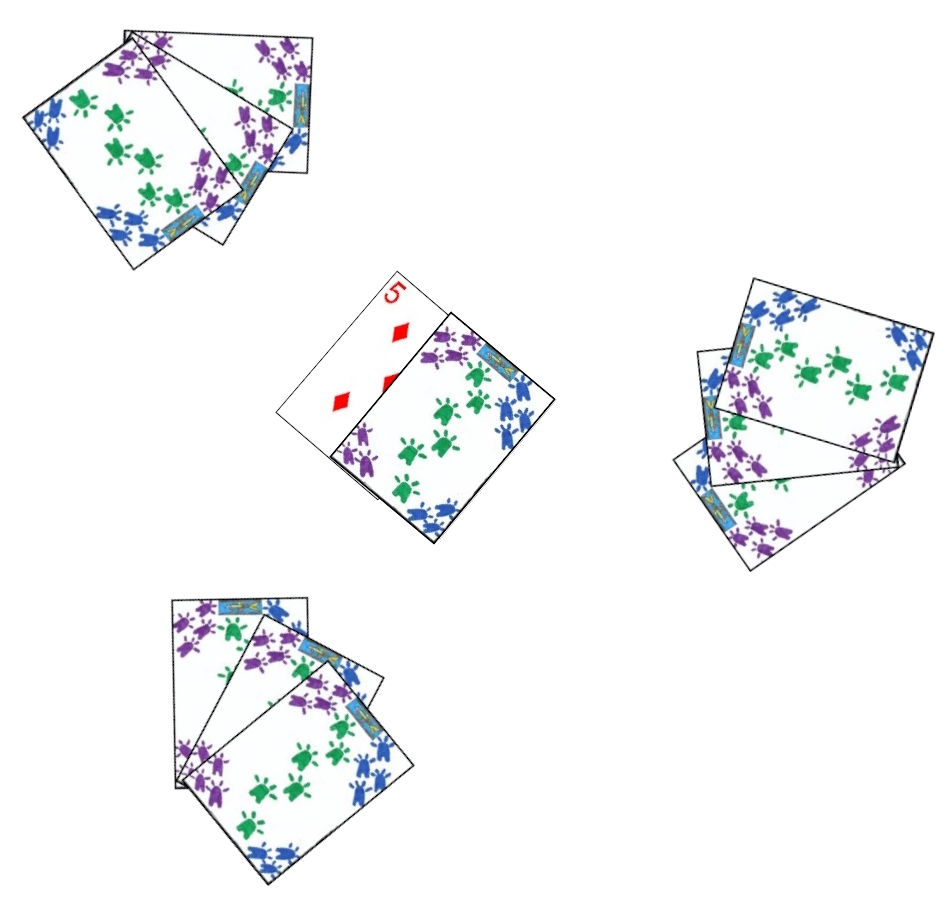
Once the players are seated and the dealer determined, he should then thoroughly shuffle the deck and offer it to the player at his right to cut. After the cut, the dealer then begins distributing the cards in a clockwise direction around the table, starting with the player at his left. He deals the cards one at a time, and face-down, continuing until each player has a total of 3 cards. He then deals the next card face-up from the remaining deck onto the table, and places the remainder of the deck in a face-down pile,
partially covering the exposed card. The suit of the face-up card on the table sets the trump suit (called
"iturufu") to be used for that hand.
The player to the immediate left of the dealer leads the first card to the first trick, with each other player, in a clockwise direction contributing one card to that same trick. The leader to a trick can play any card of choice from their hand to start the trick. Each other player must then play a card of the suit originally led to the trick if they have such a card. If they do not have a card of that suit, they may play any card from their hand, including a card from the trump suit.
After each player has played one card to the trick, it is determined who has won that trick. The highest card in the trump suit played to the trick wins it. However, if the trick contains no cards in the designated trump suit for that hand, the player of the highest card in the suit originally led to the trick wins it. The cards from the trick should be aide, face-down near the player who won that trick, out of play. The winner of that trick then draws the top card from the stock, and each other player, in a clockwise direction from this player draws a card in turn, to replenish their hand to three total cards. The last card drawn from the deck will be the exposed trump card. Once the stock has been exhausted, the players will play the last three tricks using the last three cards in their hand. The winner of each trick leads the first card to the next trick.
After every trick has been played and won the players then calculate the number of cards points capture in tricks during that hand. If the four player partnership version of the game, both players in each team should combine all the cards won in tricks during that hand for computation of scores. The following chart shows the scoring value of each card in the deck:
| Card | Point Value |
|---|
| Ace | 11 |
| 7 | 10 |
| King | 4 |
| Jack | 3 |
| Queen | 2 |
| 6, 5, 4, 3 | 0 |
Whichever player (or team in the four player variant) manages to earn the highest score is declared the game winner. If there is a tie for highest number of card points scored, the hand is a tie with no winner declared. Since each hand is essentially a complete game, a full game usually consists of a certain number of games played, and the overall winner is the team or player who wins the most individual games.
Kos: Kos is a variant of Briscola which is commonly encountered in the country of Cameroon. It uses the same 40 card deck as is used in standard Briscola with the cards having the same ranking. The most common variant of the game is played by four players in two teams of two players each, however there are also variants for two and three players.
In this four player variant, each player sits directly across the table from his partner. The dealer should thoroughly shuffle the deck and offer the deck to the player at his left to cut. During the cut, the card at the bottom of the top stack of the deck used during the cut should be shown to all players. To help the players remember this trump suit, a card of that same suit, from the discarded eights, nines or tens should be displayed somewhere
visible to all participants. The suit of this card thus sets the trump suit (called Kos) to be used for that hand. After the cut, the deck is then passed back to the designated dealer for that hand who deals out a total of three cards to each player, one-at-a-time and face-down. The remainder of the deck is then set in the middle of the table as the stock.
The player to the immediate right of the dealer leads the first card to the first trick, and each other player, in turn, plays one card to that same trick.
The leader, and each other player in a counter-clockwise direction may play any card of choice to the trick. After each player has played one card to the trick, in turn, it is determined who has won the trick. If the trick contains any cards in the trump suit, the highest such card wins the trick. If no cards from the trump suit have been played to the trick, it is instead won by the highest card in the suit originally played to it. Tricks won, should be set in a face-down pile, near one member of the team of the winner of that trick. After each trick has been won, if there are still any cards remaining in the stock, each player then draws one card from the stock, starting with the winner of the trick, and continuing in a counter-clockwise direction around the table. Once the stock has been depleted, the players continue play with the cards remaining in their hand. The winner of each trick leads the first card to the next trick.
Once the stock pile has been reduced down to exactly four cards, each player may show his partner the cards remaining in his hand.
Once all the cards have been played to tricks, scoring on the hand can occur. Each card captured during the hand has a corresponding point value, as per the following chart:
| Card | Card Point Value |
|---|
| Ace | 11 |
| 3 | 10 |
| King | 4 |
| Queen | 3 |
| Jack | 2 |
| 7, 6, 5, 4, 2 | 0 |
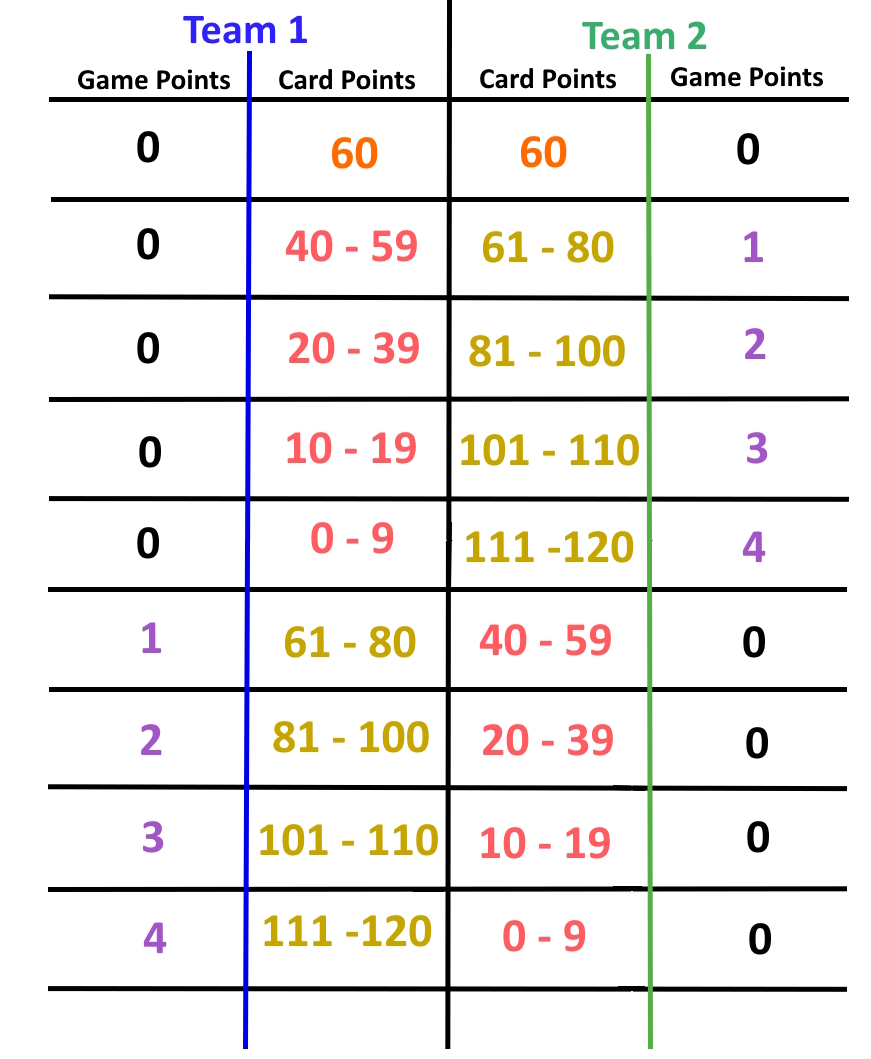
Each team then adds up the total card points both members of that team managed to win during the hand. The number of game points thus won during the hand by the team scoring the higher total is directly based on the number of points scored by the lower scoring team:
- If both teams each capture exactly 60 points during the hand, neither team scores any game points on that hand.
- If the lower scoring team scores from 40 to 59 card points, the winning team scores 1 Game Point.
- If the lower scoring team scores from 20 to 39 card points, the winning team scores 2 Game Points.
- If the lower scoring team scores from 10 to 19 card points, the winning team scores 3 Game Points.
- If the lower scoring team scores from 0 to 9 card points, the winning team scores 4 Game Points.
In addition, if the Ace of the trump suit (called Baaba) and the three of the trump suit (called Daada) are played to the same trick, by members of opposing teams, the hand immediately ends. In this event, instead of normal scoring, the team containing the player who wins the trick with the Baaba earns 6 Game Points. The player of the Daada on that trick is usually also teased mildly for allowing his card to be beaten in this way.
The first team to earn 12 or more game points is declared the game winners. If the winning team finishes with more than 12 points, this is called a tail (vichul).
Dissimilar to most variants of Briscola, in Kos, there is no signaling allowed amongst the players on a team.
Three Player Kos: Kos can also be played by three participants, each playing independently. In order to allow the cards to be divided evenly amongst the three players during play of the hand, one of the twos is removed from the deck and set aside out of play. Whichever player manages to win the highest number of card points during the hand wins the hand. In the three player variant, each hand is usually considered a complete game. In all other aspects the three player variant of Kos is played identically to the standard four player version.
Two Player Kos: Two player Kos is played identically to the four player variant of the game as described above. With the only difference being that each player plays and scores independently.
Schembil: Schembil is a variant of Briscola that is commonly found
to be played in Northern Africa. The variant apparently migrated their from Italy, as the same
rule set is also played in Southern Italy, in particular
within Sicily.
Schembil is a six player variant of Briscola, played by two teams consisting of exactly three players each. The deck used for this is a 36 card deck in which the normal 40 card deck used for play is further reduced by removing all the twos. Each player should be seated at the table between two opponents. Once the teams have been determined, each team should elect one of the players on that team as the "rais", or team captain.
The dealer would thoroughly shuffle the deck and deal as in standard Briscola, with each player receiving three total cards. The remainder of the deck is then placed in the center of the table as the stock,
with the top card turned and the suit of this card set as the trump suit
for that hand. The deal and play in Schembil is performed in a counter-clockwise direction.
Gameplay is the same as in normal Briscola, with each player selecting any card of choice from their hand to play to each trick, with the player to the immediate right of the dealer leading to the first trick, and the winner of each trick leading the first card to the next trick.
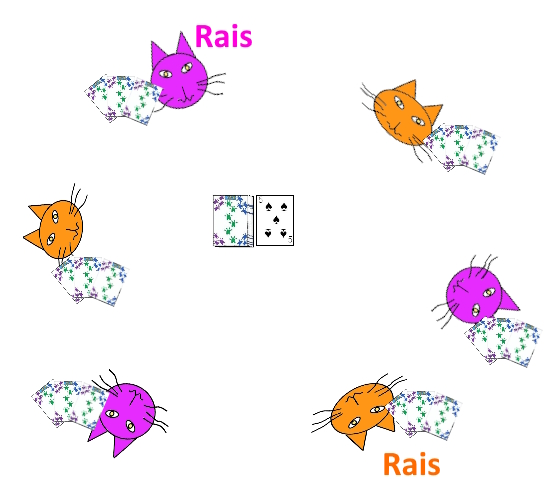
As in standard Briscola, the highest card of the trump suit played to the trick wins it, or if the trick contains no cards in the trump suit, the highest card of the suit originally led to the trick wins it.
When the last card from the stock has been drawn, the "rais" on each team is entitled to select one of his partners and look at the cards in that player's hand.
After all tricks have been played and won, each team calculates the total number of card points they managed to win during the hand. Each card has a certain card point value, which are the same as those in standard Briscola. Whichever team manages to win the majority of the card points wins the hand. If both teams win exactly 60 card points, neither team wins that hand and an additional hand must be played.
Although the signaling that is common amongst games of this type is not allowed in playing Schembil, the "rais" is entitled to ask certain questions of each of his partners and suggest their play. There are a limited number of questions the "rais" can ask, such as follows:
- The rais may ask one of his partners if they have useless cards in the hand (Lisci).
- The rais may ask the player about Briscoline cards the player may have in hand (trump cards in rank 2 to 6).
- The rais may ask the player about Vestite cards he might have in hand (trump cards in the rank of 7 and higher)
- The rais may ask a partner if he is able to win the current trick without use of a trump suit.
- The rais may ask a partner if he has any Carichi (Ace or three in non trump suits)
In response the "rais" may make specific suggestions or requests of his partners:
- To play a useless card which will not win the trick.
- To play a high trump card to the trick.
- To play a low trump card to the trick.
- To attempt to win the current trick without use of a card in the trump suit.
- To play an Ace or 3 of a non-trump suit.
Briskûla: Briskûla is the variant of Briscola that is most commonly encountered in Bosnia-Herzegovina. It is played identically to the standard game as described at the top of the page, with the following differences:
- The game is played using a 32 card deck, which can be formed from a standard 52 card deck by removing all cards lower than rank 7. The ranking of the cards as used for this game are as follows from highest to lowest: Ace, 10, King, Queen, Jack, 9, 8, 7.
- The point values of the cards as found in the deck are as follows:
| Card | Card Point Value |
|---|
| Ace | 11 |
| 10 | 10 |
| King | 4 |
| Queen | 3 |
| Jack | 2 |
| 9, 8, 7 | 0 |
- Depending on the number of players, it may come about that, once the stock (talon) is depleted, some players may have no cards to draw from the discard pile. In that event, some players may have fewer cards, and those with fewer cards will simply not play to the last trick of that hand.
Other than these differences, Briskûla is played identically to standard Briscola as described at the top of the page.
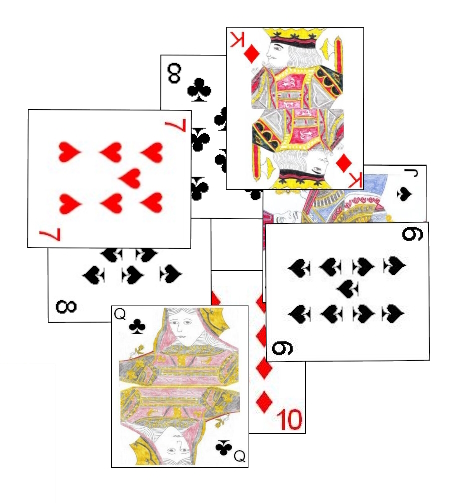 Double Briskûla
Double Briskûla: Double Briskûla is another variant of Briscola that is popular both in Bosnia-Herzegovina, but also in Serbia as well. This game is also played similarly to standard Briscola with the following differences:
Double Briskûla is played using a 32 card deck, which can be formed from a standard 52 card deck by removing all cards lower than rank 7. The ranking of the cards in this deck, as used for this game, are as follows from highest to lowest: Ace, 10, King, Queen, Jack, 9, 8, 7.
In the initial deal each player is dealt a total of four cards.
During each trick each player plays two cards to each trick. Thus, after each player has played the first card to the trick, each player then plays a second card to that same trick. Which player has played the highest card of the trump suit wins the trick, or if the trick contains no cards from the trump suit, the player of the highest card in the suit originally led to the trick wins it.
After each trick has been played and won, each player draws two cards from the talon (until the talon is exhausted with no cards remaining in it).
The point values of the cards as found in this deck are as follows:
| Card | Card Point Value |
|---|
| Ace | 11 |
| 10 | 10 |
| King | 4 |
| Queen | 3 |
| Jack | 2 |
| 9, 8, 7 | 0 |
Other than these differences, Double Briskûla is played identically to standard Briscola.
Copyright © 2015
CatsAtCards.com. All rights reserved.
 Briscola is a four player partnership card game of Italian descent and
appears to be the parent game from which several other somewhat similar
games may have been derived (i.e. Calabrasella). This game and it's
variants are considered part of the Tute family of card games. The game
was originally played using the traditional Italian pack, but can also be
played using the standard 52 card French suited deck which might be more
familiar to many players, with certain cards removed.
Briscola is a four player partnership card game of Italian descent and
appears to be the parent game from which several other somewhat similar
games may have been derived (i.e. Calabrasella). This game and it's
variants are considered part of the Tute family of card games. The game
was originally played using the traditional Italian pack, but can also be
played using the standard 52 card French suited deck which might be more
familiar to many players, with certain cards removed.



 The determination of the selected trump suit is quite unique in Belka. On the first hand of every game, the trump suit is always set as clubs. The player who is dealt the Jack of clubs on this first hand should take note of this, but need not announce it until the end of that hand. Once the first hand has been played, the recipient of that
same card in each subsequent deal helps determine the trump suit to be used in later hands. Each player is then represented by a specific suit. The player who had thus received the Jack of clubs is set, as a designator, the suit of clubs, the player to his immediate left is set as the suit of diamonds, the player at his immediate right the suit of hearts, and his partner (the player directly across from him) the suit of spades. Thus, on each hand after the first whichever player is dealt the Jack of clubs must announce this, and whatever his suit designation was, sets the trump suit to be used for that hand.
The determination of the selected trump suit is quite unique in Belka. On the first hand of every game, the trump suit is always set as clubs. The player who is dealt the Jack of clubs on this first hand should take note of this, but need not announce it until the end of that hand. Once the first hand has been played, the recipient of that
same card in each subsequent deal helps determine the trump suit to be used in later hands. Each player is then represented by a specific suit. The player who had thus received the Jack of clubs is set, as a designator, the suit of clubs, the player to his immediate left is set as the suit of diamonds, the player at his immediate right the suit of hearts, and his partner (the player directly across from him) the suit of spades. Thus, on each hand after the first whichever player is dealt the Jack of clubs must announce this, and whatever his suit designation was, sets the trump suit to be used for that hand.
 Once the players are seated and the dealer determined, he should then thoroughly shuffle the deck and offer it to the player at his right to cut. After the cut, the dealer then begins distributing the cards in a clockwise direction around the table, starting with the player at his left. He deals the cards one at a time, and face-down, continuing until each player has a total of 3 cards. He then deals the next card face-up from the remaining deck onto the table, and places the remainder of the deck in a face-down pile,
partially covering the exposed card. The suit of the face-up card on the table sets the trump suit (called
"iturufu") to be used for that hand.
Once the players are seated and the dealer determined, he should then thoroughly shuffle the deck and offer it to the player at his right to cut. After the cut, the dealer then begins distributing the cards in a clockwise direction around the table, starting with the player at his left. He deals the cards one at a time, and face-down, continuing until each player has a total of 3 cards. He then deals the next card face-up from the remaining deck onto the table, and places the remainder of the deck in a face-down pile,
partially covering the exposed card. The suit of the face-up card on the table sets the trump suit (called
"iturufu") to be used for that hand.
 Each team then adds up the total card points both members of that team managed to win during the hand. The number of game points thus won during the hand by the team scoring the higher total is directly based on the number of points scored by the lower scoring team:
Each team then adds up the total card points both members of that team managed to win during the hand. The number of game points thus won during the hand by the team scoring the higher total is directly based on the number of points scored by the lower scoring team:
 As in standard Briscola, the highest card of the trump suit played to the trick wins it, or if the trick contains no cards in the trump suit, the highest card of the suit originally led to the trick wins it.
As in standard Briscola, the highest card of the trump suit played to the trick wins it, or if the trick contains no cards in the trump suit, the highest card of the suit originally led to the trick wins it.
